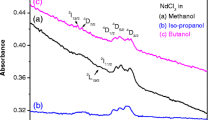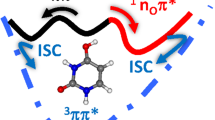Abstract
Excited state relaxation in Tb3+ in POCl3:SnCl4 aprotic solvent has been examined. It is found that at a concentration of 10−1 M Tb3+, the fluorescence exclusively originates from the5D4 level. The appreciable increase in the decay times of Tb3+ in this solvent compared to its values in H2O or D2O, suggests that the decrease in non-radiative relaxations is due to the low energy vibrations characteristic of this solvent. Non-radiative transfer of energy from Tb3+ → Nd3+ and from Tb3+ → Ho3+ in this solvent has been established by examining the lifetime data. Calculated values of energy transfer probabilities (Pda) in the liquid air temperature are analysed to obtain a clue regarding the nature of excitation transfer mechanism. In both the systems, the energy transfer from Tb3+ donors to Nd3+ as well as Ho3+ acceptors, occurs predominantly via a dipole-dipole process. At high temperature the energy transfer is increased.
Similar content being viewed by others
References
Antipenko B M, Bataev I M, Ermolaev V L, Lyubimov E I and Privalova T A 1970Opt. Spectrosc. (USSR) 29 177
Antipenko B M and Ermolaev V L 1969Opt. Spectrosc. (USSR) 26 415
Bhatt B C, Joshi G C and Pant D D 1973Indian J. Pure Appl. Phys. 11 226
Blumenthal N, Ellis C B and Grafstein D 1968J. Chem. Phys. 48 5726
Cario G and Franck J 1923Z. Phys. 17 202
Chrysochoos J 1974J. Lumin. 9 79
Chrysochoos J and Takousbalides P 1973Spectrosc. Lett. 6 435
Chrysochoos J and Takousbalides P 1975J. Lumin. 11 119
Chrysochoos J and Takousbalides P 1976J. Lumin. 14 325
Dieke G H and Crosswhite H M 1963Appl. Opt. 7 675
Heller A 1966aAppl. Phys. Lett. 9 106
Heller A 1966bJ. Am. Chem. Soc. 88 2058
Heller A 1968aJ. Mol. Spectrosc. 28 101
Heller A 1968bJ. Mol. Spectrosc. 28 208
Holloway W W Jr and Kestigian M 1967J. Chem. Phys. 47 1826
Kropp J L and Windsor M W 1963J. Chem. Phys. 39 2769
Kropp J L and Windsor M W 1965J. Chem. Phys. 42 1599
Kropp J L and Windsor M W 1966J. Chem. Phys. 45 761
Lempicki A and Heller A 1966Appl. Phys. Lett. 9 108
Pant D D, Bhatt B C and Sanwal D N 1971Indian J. Pure Appl. Phys. 9 324
Siebrand W and Williams E 1968J. Chem. Phys. 49 1860
Tokousbalides P and Chrysochoos J 1972J. Phys. Chem. 76 3397
Tokousbalides P and Chrysochoos J 1974Chem. Phys. Lett. 29 226
Tokousbalides P and Chrysochoos J 1976J. Chem. Phys. 64 1863
Author information
Authors and Affiliations
Rights and permissions
About this article
Cite this article
Joshi, J., Joshi, J.C. Excited state relaxation and energy transfer between Tb3+ → Nd3+ and Tb3+ → Ho3+ in POCl3:SnCl4 . Proc. Indian Acad. Sci. (Chem. Sci.) 96, 103–113 (1986). https://doi.org/10.1007/BF02863303
Received:
Issue Date:
DOI: https://doi.org/10.1007/BF02863303




